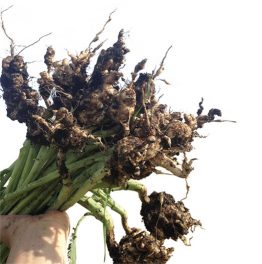What does clubroot resistance mean?
 Clubroot-resistant (CR) canola varieties are key tools used to delay clubroot establishment and manage clubroot disease on the farm. However, to prevent rapid genetic shifts in clubroot populations and subsequent loss of effective resistance, these CR varieties must be used in an integrated management approach, which includes practicing a diverse crop rotation with at least two years between canola crops, effectively managing weeds, sanitizing equipment and minimizing soil movement.
Clubroot-resistant (CR) canola varieties are key tools used to delay clubroot establishment and manage clubroot disease on the farm. However, to prevent rapid genetic shifts in clubroot populations and subsequent loss of effective resistance, these CR varieties must be used in an integrated management approach, which includes practicing a diverse crop rotation with at least two years between canola crops, effectively managing weeds, sanitizing equipment and minimizing soil movement.
Resistant, Intermediate and Susceptible
Through Western Canada Canola/Rapeseed Recommending Committee (WCC/RRC) protocols, varieties are compared to the susceptible check variety for clubroot infection and are assigned either resistant (R), intermediate (I) or susceptible (S) ratings.
As noted in Table 1, R varieties are not immune but they highly restrict the development of clubroot symptoms in fields with low to moderate disease pressure from resting spores in the soil. If a variety has no CR label, assume it is susceptible to clubroot.
“Even when growing a CR variety, growers have to check for clubroot to make sure the disease stays below expected levels. If it seems to be worse than it should be, the variety may not have resistance to the predominant pathotype in the field,” says Dan Orchard, Canola Council of Canada agronomy specialist for Central Alberta North.
No varieties R to all pathotypes
A base R label requires that the variety is resistant to the predominant clubroot strains or pathotypes in Western Canada. Additional ratings can be appended to the base R label to describe resistance to specific uncommon or new pathotypes.
No CR varieties, including new ones with multiple resistance genes, are resistant to all of the clubroot pathotypes detected in Western Canada to date. As clubroot populations in infested fields become more diverse over time, and more CR resistance genes are bred into canola varieties, the usefulness of rotating CR varieties with different resistance will increase. Currently there are no tests commercially available for growers to distinguish or detect new virulent strains in their infested fields.
Who should grow CR varieties?
Canola growers who have clubroot on the farm should definitely use clubroot-resistant (CR) varieties. If clubroot is found anywhere in the municipality, county or district, CR varieties will reduce the build of spores in a field if (when) clubroot moves onto your farm. If you don’t know whether clubroot is in your area, CR varieties can be a useful prevention tool. You can also submit soil and plant samples to a lab to be tested for the presence of clubroot DNA.
“The risk of using a CR too early and contributing to breaking of the resistance is small compared to the risk from not using a CR variety early and having the disease escalate quickly to very costly levels,” Orchard says.
Visit clubroot.ca to learn more about clubroot prevention, detection and management, including a list of labs that provide DNA analysis.
| Resistant (R) | Intermediate (I) | Susceptible (S) | |
|---|---|---|---|
| Classification | Less than 30% infection compared to susceptible checks in disease tests. | Between 30 and 50% infection compared to susceptible checks in disease tests. | More than 50% infection compared to a susceptible check. |
| What this means | (R) varieties are not immune, but highly restrict the development of clubroot symptoms in fields with low to moderate disease pressure from resting spores in the soil. | This (I) rating will mostly be used for adding rating labels to the base (R) label in multiple-resistance gene varieties to specify moderate resistance against certain new strains. | If there is no CR label on a variety, assume it is susceptible to clubroot. An (S) label could be added to a base (R) label to specify susceptibility to certain strains that aren’t common. |
| What to expect | Under heavy pressure in severely infested fields, an (R) variety can show significant root galling, but may develop fewer and smaller galls than a susceptible variety. Under these heavy pressure situations and frequent use of CR varieties, clubroot populations rapidly evolve to strains that overcome the resistance. | Although intermediate resistance may restrict the development of clubroot symptoms for the corresponding strains, the spore concentration in the soil will be increased. | An extreme buildup of spores can occur very quickly when susceptible varieties are grown in short rotation on slightly infested fields. |
| Management tips | To delay this shift in clubroot strains and loss of CR variety efficacy, CR varieties should not be grown in short rotations in infested fields. | Varieties with additional (l) labels can provide marginally better disease protection on fields with presence of new corresponding strains, but should not be grown in fields where resistance to predominant strains has been widely defeated. | Susceptible varieties should not be grown in clubroot-infested fields, or those at risk of becoming infested soon. |




